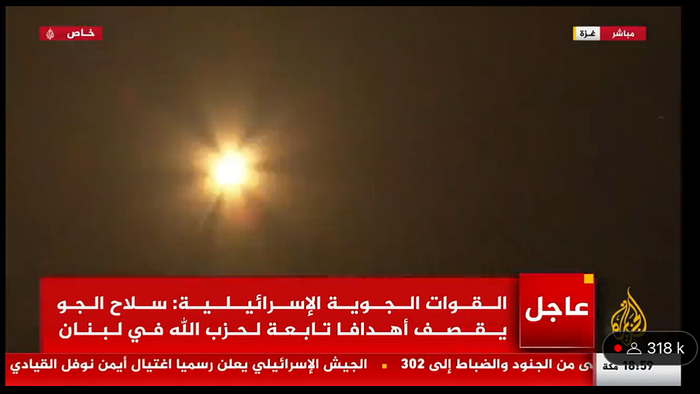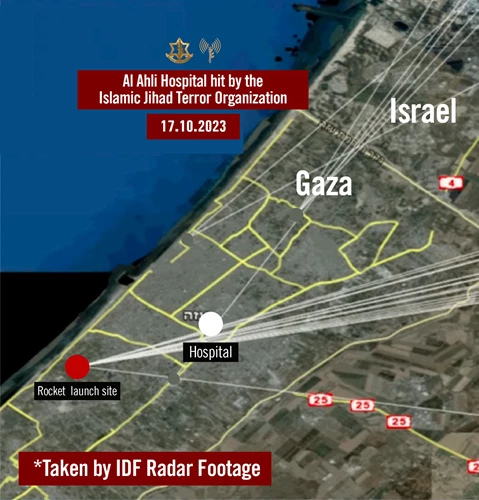
When an explosion caused mass casualties at al-Ahli hospital in Gaza last week it was scarcely surprising that Palestinians — along with many others — assumed Israel was responsible.
Israel had already phoned the hospital more than once to demand its evacuation, and a strike the previous Saturday, reportedly by Israel, had caused damage on two floors and injured four people. The area had again come under fire on the evening of Tuesday’s deadly explosion: in the quarter-hour before the hospital was hit al-Jazeera television’s live-feed camera recorded four strikes nearby.
Next morning, after a night poring over the intelligence, Israel called a news conference, denied any role in the tragedy, blamed it on a malfunctioning Palestinian rocket and made a plausible case in support of that claim. Later that day President Biden accepted Israel’s explanation, telling prime minister Netanyahu: “Based on what I’ve seen, it appears as though it was done by the other team, not you.”
There are many who now share Biden’s opinion — and with good reason. Perhaps the most telling sign is that “the other team” has made no serious effort to counter Israel’s narrative. Hamas had access to the explosion site and if any evidence of an Israeli munition had been found in the wreckage it would surely have said so by now.
Based on current information an accident involving a Palestinian rocket is the most likely scenario but exactly what happened is still far from clear.
Identifying the launch location
The first puzzle, assuming the suspect rocket was fired from Gaza, is the spot it was launched from — because Israel has given two conflicting locations.
A graphic posted on the IDF’s website — which is said to be based on radar data — shows a salvo of rockets fired from a spot 2–3 km south-west of the hospital. The graphic indicates these rockets were on a flight path that would have taken them over the hospital or close by. The implication is that one of them malfunctioned and crashed into the hospital’s car park.

That is contradicted by a timeline on the IDF website which says that at 18.59 on Tuesday “the Palestinian Islamic Jihad (PIJ) fired a barrage of ten rockets at Israel from a cemetery near the Al-Ahli Baptist Hospital in Gaza” and that “reports immediately emerged of an explosion at the hospital”. The cemetery in question is adjacent to the hospital compound, on its western side.
An intercepted phone call
The cemetery also figures in a recording circulated by Israel which is said to be an intercepted phone conversation between two Hamas operatives. Key points from the conversation are that Islamic Jihad launched a rocket from the cemetery and it misfired. According to one of the speakers shrapnel found at the scene was “local shrapnel and not like Israeli shrapnel”. (The recording, together with a transcript, is posted in the “supplementary evidence” section of the IDF website.)
On Wednesday Channel 4 News reported that the authenticity of the recording was being questioned by some native Arabic speakers on the grounds that “the tone, syntax, accent and idiom are absurd”. So far, though, no one has come up with a detailed linguistic analysis.
Language aside, the recording also has a couple of odd features. One is that both speakers sound remarkably calm considering what had just happened. The other is the lengthy pauses between one person speaking and the other replying. In typical phone calls people tend to interrupt and talk over each other.
Alex Thomson, who reported the story for Channel 4 News, says the IDF was invited to comment but did not respond directly to the issues raised. Instead, the IDF said had given an accurate account but for “operational security” reasons could not release all the information it held.
A recording in stereo
Shortly after the recording was circulated several X/Twitter users noted that it was in stereo and wondered how that could have happened with an intercepted phone call.
In a series of posts on Friday, @earshot_ngo — which specialises in “sonic investigations” commented:
“When calls are intercepted, we would expect them to be single monophonic recordings with both voices on the same channel of audio. What is unusual in this alleged intercepted call is that we have the voices divided across two channels, left and right.
“The fact that this recording is made up of two separate channels demonstrates that these two voices have been recorded independently. These two independent recordings have then been edited together with added effects (such as pan control).
“Though this audio analysis cannot categorically state that the audible dialogue is fake, Earshot.ngo’s opinion is that the level of manipulation required to edit these two voices together disqualifies it as a source of credible evidence.”
Whatever the reasons for this manipulation, the Israeli authorities clearly have some explaining to do.
Clues in the car park
A notable feature of the explosion site is that photos taken next day show no fragments from the munition that caused it— which suggests they had been hastily removed overnight. War crimes investigator Marc Garlasco told CNN: “When I investigate a site of a potential war crime the first thing I do is locate and identify parts of the weapon. The weapon tells you who did it and how. I’ve never seen such a lack of physical evidence for a weapon at a site. Ever.”
In the absence of such evidence munitions experts have been left pondering what sort of weapon could have caused the damage seen in photos of the aftermath. It’s clear that whatever hit the hospital caused a huge fire in the car park which was probably also fuelled by petrol in the burning cars. There was also an explosion, though the blast was relatively small. It crushed two cars, overturning one of them, but buildings suffered no structural damage. There were some broken windows and missing roof tiles.
Experts have struggled to identify an appropriate type of Israeli munition, arguing instead that the damage is more consistent with a failed rocket launched from inside Gaza. A small explosive power is typical of Palestinian rockets rather than Israeli ones, and the initial fireball could be explained by a rocket failing seconds after launch while still almost full of propellant.
Questions about a crater
Another feature seen in photos is a small crater which appears to have been caused by the munition’s impact. In a preliminary analysis the Bellingcat investigative website noted: “The ground surrounding one side of the crater shows a cone of scarring and pitting, consistent with the explosion of a munition at this site. Objects within this cone appear to have suffered extensive damage, including a fence which was largely destroyed by the explosion.”
According to the IDF (and others) the crater’s small size indicates it was not caused by an Israeli munition. Bellingcat quoted IDF spokesperson Jonathan Conricus as saying: “Scroll through pictures of rockets that impacted in Sderot, Ashkelon, in Be’er-Sheva, you’ll see very similar sites … A small crater, lots of soot and fire remarks [sic] and you can see that all of the buildings around are generally intact. If a big Israeli bomb had been dropped here, none of this would have been intact.”
Meanwhile Forensic Architecture, a research group connected with the University of London, has questioned whether evidence from the crater is consistent with a Palestinian-fired rocket travelling west to east.
Preliminary analysis, it says, “shows patterns of radial fragmentation on the southwest side of the impact crater, as well as a shallow channel leading into the crater from the northeast. Such patterns indicate a likely projectile trajectory with northeast origins.”
In other words, the suggestion is that the munition could have been fired from Israel. One problem, though, is that a malfunctioning rocket launched from the west in Gaza would not necessarily maintain its original course and could easily crash to earth heading in a different direction.
However, there’s support for Forensic Architecture’s claim from @earshot_ngo, the “sonic investigations” group that analysed the stereo recording of the “Hamas operatives” phone call.
Earshot.ngo compared the whistling sound of the munition in two videos — one filmed 150 metres south-east of the hospital and the other 1,500 meters to the north-west. By analysing the Doppler Effect in the sound at these two locations it deduced that the munition was likely to have come from an easterly direction.
A wayward rocket?
During the minute before the hospital strike cameras also recorded a mid-air explosion. The timing has given rise to speculation that the two events could be connected, though so far there’s no actual evidence to link them.
Video shows an object — presumably a rocket — rising into the night sky. It suddenly appears to veer off course, there’s a mid-air explosion and it vanishes from the screen. Shortly afterwards a small flash is seen at ground level in the distance followed by a larger burst of fire at what is generally believed to be the location of al-Ahli hospital.
The are competing theories about what the video shows. Some say it’s a Palestinian rocket that self-destructed after a malfunction, others that the mid-air explosion was an interception by Israel’s Iron Dome anti-missile system. Either way, the suggestion is that the rocket seen in the video, or what was left of it, crashed to earth in the hospital car park, causing the explosion there.
It’s not uncommon for Palestinian rockets to malfunction, and while it’s possible that a failed rocket from either of the two launch sites cited by Israel caused the hospital explosion, it’s questionable whether that could be the same rocket seen in the video. The main issue is whether enough of it would have survived to cause the damage in the car park.
Among those disputing that the rocket in the video was responsible for the deaths and destruction at the hospital is Aljazeera television, whose live feed from Gaza recorded the rocket’s flight. According to Aljazeera, the video shows it was “completely destroyed and broken up” by an interception from the Iron Dome.
However, it’s unlikely that Iron Dome could have intercepted a rocket flying over the hospital: it would be too soon after the launch. The system analyses the trajectory of incoming rockets and intercepts them if it calculates they are heading for a populated area. It can’t do this until the trajectory is clear — which mean interceptions usually take place over Israel rather than Gaza.
The question that raises, if the video footage does show an interception, is where it took place. By triangulating from videos recorded in different locations OSINT analyst Oliver Alexander concludes that they show an interception just on the Israeli side of the Gaza fence.

If Alexander is right about that, the event seen in the video is unlikely to be connected with the explosion at the hospital. In a thread on X/Twitter, he notes: “The airborne detonation happened approx 8 seconds prior to the hospital blast, approx 4.3 km away. Given the altitude of the blast, the distance is closer to 5.5km.”
If this were responsible for the blast, he adds, the remains would have had to travel at almost 2,500 km per hour in order to hit the hospital eight seconds later.

 RSS Feed
RSS Feed
